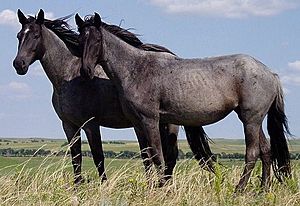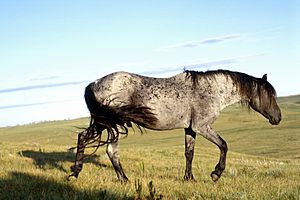Nokota horse facts for kids

Two young horses
|
|
| Distinguishing features | Angular frame, often blue roan, often exhibits an ambling gait |
|---|---|
| Country of origin | United States |
| Breed standards | |
| Nokota Horse Registry | Breed standards |
| Horse (Equus ferus caballus) | |
The Nokota horse is a special breed of horse that lives in the `badlands` of southwestern `North Dakota`, `United States`. These horses are `wild` or `partly wild`. The breed started in the 1800s. It came from horses owned by local `Native American` people, mixed with `Spanish horses`, `Thoroughbreds`, and `harness horses`.
In the early 1900s, the Nokota horse almost disappeared. Ranchers and government groups worked to reduce the number of wild horses. This was because the horses ate grass that livestock also needed. But when `Theodore Roosevelt National Park` was made in the 1940s, some horse groups were accidentally trapped inside. This helped to save them.
In 1986, the park sold many of these horses. Brothers Leo and Frank Kuntz started buying them to save the breed. They created the Nokota Horse Conservancy in 1999. This group also started a `breed registry` to keep track of the horses. Today, the park keeps the horse numbers between 70 and 110. They sell the extra horses.
The Nokota horse has a lean body shape. They are often `blue roan` in color, which is a mix of black and white hairs. They often have a special `ambling` `gait` (way of walking) called the "Indian shuffle." There are two main types: the traditional type and the ranch type. These types look a bit different and are used for many activities. This includes `endurance riding` (long-distance riding) and `western riding`.
Contents
What Makes Nokota Horses Special?
The Nokota horse has a lean body. It has clear `withers` (the ridge between the shoulder blades), a sloped `croup` (the top of the hindquarters), and a tail that is set low. Many Nokota horses are `blue roan`. This color is rare in other horse breeds. `Black` and `gray` are also common colors. Less common colors include `red roan`, `bay`, `chestnut`, `dun`, `grullo`, and `palomino`. Sometimes, they have `pinto` patterns like `overo` and `sabino`.
There are two main kinds of Nokota horses. The first is the traditional Nokota. This type is smaller and more refined. They look more like the `Colonial Spanish Horse`. They usually stand between 14 and 14.3 hands (56 and 59 inches, 142 and 150 cm) hands high. (One hand is about 4 inches or 10 cm).
The second type is called the ranch-type. These horses look more like early `Quarter Horses`. They are usually taller, from 14.2 to 17 hands (58 to 68 inches, 147 to 173 cm) hands high. Nokota horses often have a smooth `ambling` `gait` called the "Indian shuffle." People say Nokota horses are smart and can do many things. They are used in `endurance races` and `western riding`. Some are also used in `fox hunting`, `dressage`, `three-day eventing`, and `show jumping`.
The name "Nokota" might come from the `Nakota` people. They lived in North and South Dakota. Another idea is that the Kuntz brothers combined "North Dakota" to create the name.
The Story of the Nokota Horse
The Nokota horse developed in the `Little Missouri River Badlands` in `North Dakota`. `Wild horses` were first seen by `ranchers` in the 1800s. Horses from `tame herds` mixed with these wild groups. Ranchers often `crossbred` local Native American ponies, Spanish horses, and different `draft`, `harness`, `Thoroughbred`, and `stock horses`. They did this to create strong, useful ranch horses.
Theodore Roosevelt, who had a ranch in the Little Missouri area from 1883 to 1886, wrote about these horses. He said that in many places, there were wild horses. Even though they came from tame horses that ran away, they were as wild as the antelope.
In 1884, the HT Ranch bought 60 mares (female horses) from a group of 250 Native American-bred horses. These horses were taken from the `Lakota` leader `Sitting Bull` in 1881. Some of these mares were bred with a famous `Thoroughbred` racing `stallion` named `Lexington`.
By the early 1900s, wild horse groups became a problem for ranchers. The ranchers wanted to stop the horses from eating grass that their livestock needed. Many horses were rounded up. They were either used as ranch horses, sold for `meat`, or shot. From the 1930s to the 1950s, government groups worked with ranchers to remove horses from western North Dakota.
However, when `Theodore Roosevelt National Park` was created in the 1940s, some horse groups were accidentally fenced inside. By 1960, these were the last wild horses left in North Dakota. The park wanted to get rid of these horses. The National Park Service was not included in the `Wild and Free-Roaming Horses and Burros Act of 1971`. This law protected wild horses on other federal lands. So, the park could treat the horses as a problem and send many to `slaughter`.
In the late 1970s, people started to protest against removing wild horses. This led to changes in how the park managed the herds. Today, the horses in Theodore Roosevelt National Park are kept for historical reasons. But in 1986, the park added new horse bloodlines. They wanted to change how the Nokota horses looked. Park managers thought the new horses would sell better at auctions. They removed the main `stallions` and brought in two `wild` `stallions` from `Bureau of Land Management` `Mustang` herds. They also added a `crossbred` `Shire` `stallion`, a `Quarter Horse` `stallion`, and an `Arabian` `stallion`.
At the same time, many horses from the park were rounded up and sold. At the 1986 auction, Leo and Frank Kuntz bought 54 horses. They were worried about the Nokota horse. They also bought smaller groups of horses in 1981, 1991, and 1997. After studying the breed's history, the Kuntz brothers believed the park horses were related to the horses from Sitting Bull's group. These horses had been raised by the `Marquis de Morès`, who founded the town of Medora.
From the 1990s to Today
By 1993, the Kuntz brothers had a group of 150 horses. These included the horses they bought from the park and their offspring. They used the horses mainly for ranch work and `endurance races`. In 1993, the Nokota was named the Honorary State Equine of North Dakota.
In 1994, researchers studied the horses in the park and on the Kuntz ranch. They found that only about 20 horses on the ranch had traits of the `Colonial Spanish Horse`. Since then, the Kuntz ranch has bred their horses to keep and improve their Spanish traits. In 1999, the Kuntz brothers started the Nokota Horse Conservancy. This group works to protect and save the Nokota horse. The Conservancy keeps records of about 1,000 horses, both living and past. Nokota horses can now be found all over the `United States`.
Theodore Roosevelt National Park still thins the horse herd. They have done several roundups in the 1990s and 2000s. In 2000, the last horses that were considered "traditional" Nokota type were removed from the wild. Some of these were bought by people who supported the Nokota Horse Conservancy. The National Park Service now keeps a herd of 70 to 110 horses.
In 2006, the Nokota breed was chosen for `Breyer Animal Creations'` "Benefit Horse" Campaign. A Breyer model horse was made and sold in 2007. Part of the money from sales went to the Nokota Horse Conservancy. As of 2006, the Kuntz family owned about 500 Nokota horses. The Nokota Horse Conservancy owned another 40. At that time, there were fewer than 1,000 Nokota horses alive in the world.
The Nokota Horse Registry is the main group that registers Nokota horses. It is run by the Nokota Horse Conservancy. There was another group called the Nokota Horse Association, but it did not last long. In 2009, the two groups argued over who had the right to the Nokota breed name. A court ordered the Association to stop registering horses, and it soon disappeared.
In the fall of 2009, another group was created: the North Dakota Badlands Horse Registry. This group registers horses that have been removed from the park recently. These horses are a bit different from those registered by the Nokota Horse Registry. This is because the park added blood from different breeds to the herds. As of March 2011, about 40 horses had been registered by this new group.
See also
 In Spanish: Caballo Nokota para niños
In Spanish: Caballo Nokota para niños



